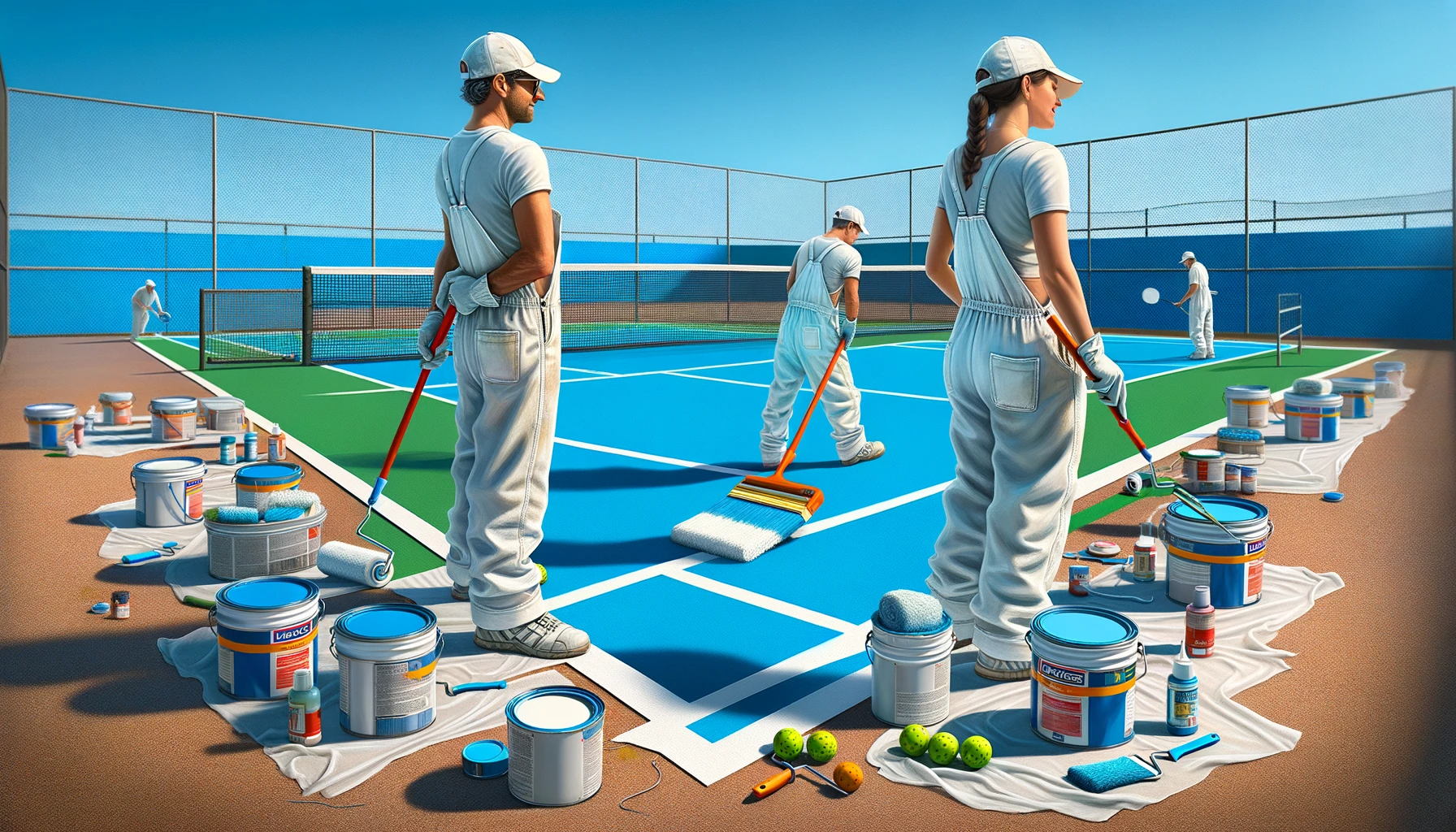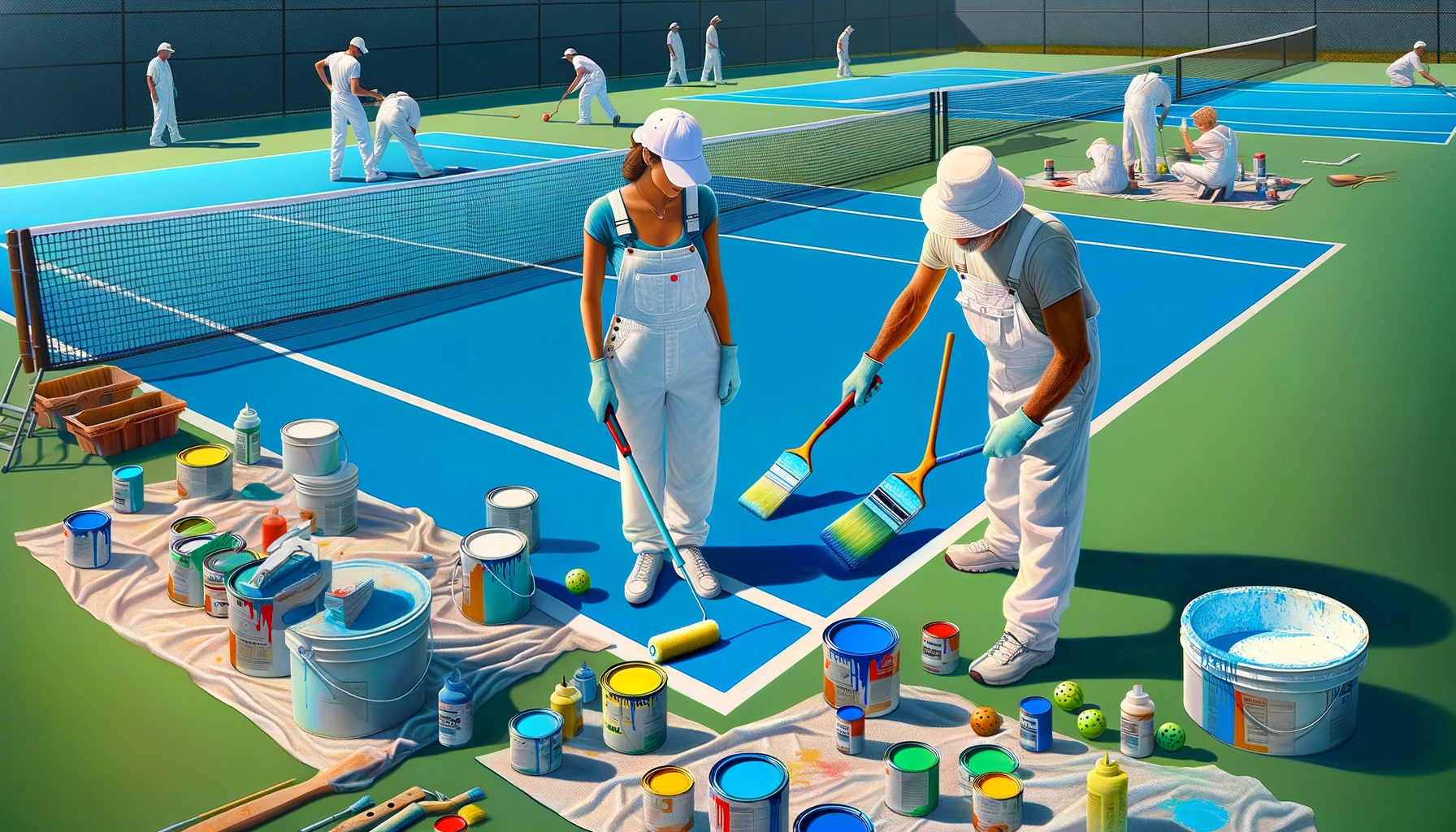When investing in new pickleball court construction or converting existing tennis courts, a key consideration is choosing the right playing surface.
The court surface not only impacts playability and performance, but also longevity and maintenance needs. One of the biggest maintenance requirements for any sport court surface is re-coating and re-lining over time.
So how often should you plan to re-coat your pickleball courts?

Factors That Impact Re-Coating Frequency
There are several variables that will determine how often your pickleball courts need to be re-coated:
Court Surface Material
The underlying court surface material will impact re-coating needs. Here are some guidelines:
- Asphalt courts – Tend to require re-coating every 2-4 years on average due to weathering.
- Post-tension concrete courts – Can go 4-8 years between re-coating depending on climate and usage.
- Poured-in-place rubber courts – Require re-coating every 3-5 years typically.
- Modular tile courts – Usually need re-coating every 3-4 years.
Climate and Weather
Environmental factors also play a key role. In hot climates, UV exposure can degrade court coatings more rapidly. In areas with harsh winters, freeze/thaw cycles take a toll. Frequent rain or snow also accelerates surface wear.
Levels of Use
High traffic courts will need re-coating more frequently than courts with only occasional use. School and municipal courts often see heavy daily use, shortening the interval between re-coatings. Private residential courts with limited players can sometimes go years longer between applications.
Quality of Initial Application
The longevity of the coating system is heavily dependent on proper surface prep and application. Using experienced contractors and quality materials from the start will extend the useful life of the coating before needing renewal.
Court Maintenance
Proper maintenance such as sweeping and power washing will preserve the playing surface longer before re-coating is required. Letting debris accumulate or not addressing cracks promptly shortens the lifespan of the coatings.
- Where Are Pickleball Courts at Jones Beach?
- Do You Need a Court to Play Pickleball?
- How Big Is A Pickleball Court? Complete Guide to Pickleball Court Dimensions
Best Practices for Re-Coating Pickleball Courts
To maximize the time between re-coatings, it’s important your contractor follow proven best practices:
- Thoroughly clean the surface – Remove all dust, dirt and debris before applying new coatings. This provides the best bonding surface.
- Repair cracks and defects – Fill any cracks or depressions with suitable patch materials to provide a smooth surface.
- Apply primer – Priming coat enhances adhesion and durability of the color finish system.
- Apply two finish coats – Two layers of finish paint/coating gives better coverage and longevity.
- Use compatible products – Don’t mix different brands or types of coatings. Use products designed to work together.
- Mask lines neatly – Careful taping ensures crisp, straight boundaries on playing lines.
- Allow proper curing times – Observe manufacturer’s recommendations for drying between coats and before allowing play.
Following these best practices will help the new coatings last longer and provide consistent playability over time.
Typical Costs for Pickleball Court Re-Coating
Re-coating prices can range quite a bit based on the size of the court, surface type, and number of courts being done. Here are some typical price ranges:
- Single asphalt or post-tension concrete court – $1,500-$2,500
- Pair of asphalt or post-tension concrete courts – $2,500-$4,500
- Set of 4 asphalt or post-tension concrete courts – $5,000-$9,000
- **Single poured rubber or tile court **- $1,000-$2,000
- Pair of poured rubber or tile courts – $1,800-$3,500
Keep in mind regional variances in labor and material costs will also impact pricing. And additional surface repair work if needed will increase the total project investment.
- 17 Pickleball Court Etiquettes You Should Follow in 2023
- Cost Of Installing A Pickleball Court in 2024
- The Complete Guide to Building a Pickleball Court on Grass
When Is It Time for A Complete Court Re-Build?

While re-coating pickleball courts every 3-8 years is recommended, there comes a point when the underlying court has degraded to where re-surfacing is more appropriate than re-coating. Signs it may be time for a tear-out and full re-build include:
- Extensive alligator cracking throughout the court
- Large patches of settled or depressed areas
- Drainage issues and birdbaths that can’t be remedied through patching
- Heaving or buckling from freeze/thaw cycles
- Complete delamination of coating from underlying surface
- Inability to achieve a flat, smooth playing surface with re-coating
- Overall unsafe playing conditions
The costs for a complete pickleball court re-build are significantly higher than re-coating – from $15,000-$30,000+ for a set of courts. But there comes a point where the underlying integrity of the court is too far gone and a full replacement provides the best long-term solution. Your contractor can best advise you on whether re-coating or re-building is most appropriate based on detailed assessment of current court conditions.
Work With Experienced Contractors
Getting the right advice upfront on re-coating schedules, surface prep, materials selection and application methods is key to maximizing the lifespan of your pickleball court surfaces. Be sure to work with reputable contractors who specialize in sport court construction and have expertise in the latest processes, equipment and coatings technology specific to pickleball courts.
With proper planning, regular maintenance, and following re-coating best practices, you can expect quality pickleball court surfaces to provide many years of fun and play. Investing in re-coating or re-surfacing at the right intervals will keep your courts looking great while maintaining safe, consistent playing performance pickleball enthusiasts will love.
Resources:
- https://keystonesportsconstruction.com/why-is-it-important-to-have-your-tennis-court-resurfaced/
- https://alishuttler.com/tennis-court-resurfacing
- https://athletasportcourts.com/tennis-and-pickleball-courts/
- Are Badminton and Pickleball Courts the Same?
- Pickleball Court Fence Dimensions (With Budget Estimate)
- How Much Does a Pickleball Court Cost? A Detailed Look at Traditional, Synthetic, and VersaCourt Prices
- Pickleball Court Flooring Guide (Which Type is Best?)
- Do You Need a Court to Play Pickleball?
- Cost Of Installing A Pickleball Court in 2024
- Pickleball Court vs Badminton Court (Detailed Comparison in Courts)
- What Are Pickleball Courts Made Of?
- Where to Play Pickleball Indoors
- Does Disney World Have Pickleball Courts
- Does Pickleball Cause Plantar Fasciitis?
- Where Can I Play Pickleball in Calgary?
- Why Is Pickleball a Lifetime Activity?
- When Are Pickleball Nationals?
- Noble Park Pickleball Courts Closed for Touch-Ups Starting Monday
- 15 Best Wide Court Shoes For Pickleball (2023)
- What Color Should Pickleball Lines Be?
- Yew Tee Resident’s Quest to Silence Nightly Pickleball Games Hits Roadblock
- What Service Box Should the Serve Be Delivered to in Pickleball
- Common Mistakes to Avoid as an Intermediate Pickleball Player
- Why Is Pickleball Gaining Popularity? 5 Facts
- Is Pickleball Rally Scoring
